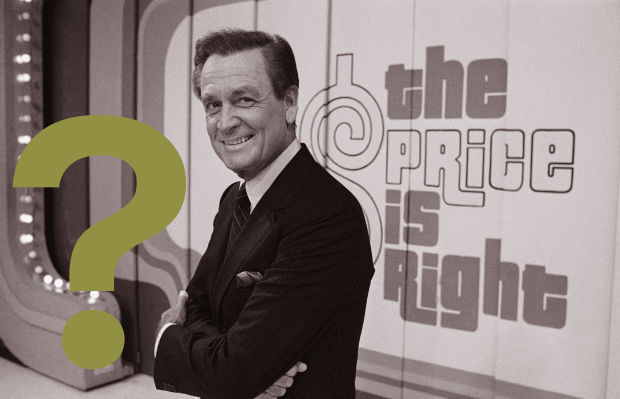Come On Down, Let’s Play… Is The Price Right?
Valuation: The First in a Three-Part Series
“Price is what you pay and value is what you get.”
~ Warren Buffet
“Intelligent investing is value investing – acquiring more than you are paying for.”
~ Charlie Munger (Warren Buffet’s long-time partner at Berkshire Hathaway).
Let’s talk prices. To do so, we don’t need Bob Barker, but we will need to choose some valuation tools. There are dozens, maybe hundreds of ways to consider if an individual stock or broader stock market index is expensive or cheap vs historical pricing. All of these valuation measures have imperfections. As you can imagine, investors have their favorite valuation tools that vary by focusing on expected earnings, earnings after stripping out certain items, sales, cash flows, ect. That is what makes stock market investing more art than science. We’ll look at three useful valuation measures in this blog—the Buffet indicator, the standard P/E, and the Shiller P/E.
THE BUFFET INDICATOR
We can’t talk about value investing without mentioning Warren Buffet, a follower of Benjamin Graham, the father of value investing. The Buffet Indicator (below) uses the price of the broad stock market divided by the overall output (GDP – Gross Domestic Product) of the U.S. economy. This is an excellent big picture measure of what you have to pay for what you get. The Buffet Indicator’s greatest strength and greatest weakness is that the measure is not directly based on corporate earnings as reported. This measure reduces the volatility of earnings by taking the perspective that the U.S. economy’s output is the same as the U.S. economy’s earnings through time. Next month you will see how accurate that assumption is over time.
As you can see, the market appears ~20% overvalued at present vs historical levels (net of inflation). Mr. Buffet would no doubt point out that interest rates (the discounting factor for the stock market) are well below historical levels, thus leaving stocks cheap to fairly priced.
PLAIN VANILLA P/E
Perhaps the most common valuation ratio is a stock’s Price/Earnings, or P/E ratio. The P/E ratio is typically based on the Last Twelve Month (LTM) of earnings and the ratio captures how much an investor is paying (P) for each dollar of earnings (E). Sometimes this ratio can be inverted and quoted as an earnings yield (E/P) to better compare to the yield an investor may be able to earn on a bond.
For instance, if a stock has a price of $25 and earns $1 per year, that stock would have a P/E of 25 or an E/P yield of 4%. Taken throughout time, 25 is a very high P/E ratio; however, when compared with U.S. Treasuries at or below 2.5%, a stock with a 4% earnings yield and a chance to grow earnings over time, it may look like a decent price to pay for what you get.
One drawback to the standard P/E ratio is that often times the earnings for a company may drop to a very small number or even a negative number during a recession. During rapidly shifting times, the P/E ratio can be volatile and a source of uncertainty for value investors. A company may look even more expensive if its price drops from $25 to $10, but earnings drop from $1 to ten cents a share. Under this scenario, the P/E ratio is 100, even though the stock is down 60%. Conversely, cyclical companies may look cheap at the wrong time—at “peak” earnings just prior to an earnings recession. Since markets are often in flux, going into or out of recession, or simply weighing the odds of recession against the ends of animal spirits, the standard P/E ratio can take investors on a wild ride.

Data extracted from dqydj.net, graph created by Altos Investments
THE MAGIC CAPE
To reduce some of these analytical challenges of the standard P/E, we look to the Cyclically Adjusted Price to Earnings Ratio, also known as CAPE or the Shiller P/E Ratio, a measurement conceived by Robert Shiller. CAPE adjusts past company earnings by inflation and compares stock prices to the ten-year average, inflation-adjusted earnings, as opposed to the nominal earnings over just the last twelve months. CAPE is more like a movie clip, whereas the standard P/E is more like a snapshot. The net result and graph contour of the CAPE chart below is more smoothed in a fashion that is similar to the Buffet Indicator chart.

Data extracted from dqydj.net, graph created by Altos Investments
CHOOSING THE RIGHT VALUATION FOR THE JOB
The charts below show the two PE measures side by side. Shiller’s measure provides a steadier read on markets and better long-term perspective for determining the aggregate market’s valuation. The CAPE Shiller model represents ten years of market information in one number that tells you how the market is priced now. It’s a valuation tool that cuts through the noise and takes a broader and deeper view of the price you pay for what you get. For these reasons, CAPE is the valuation measure that we will use in the subsequent two parts of this three-part series.

Data extracted from dqydj.net, graph created by Altos Investments
Robert Shiller won a Nobel Prize for Financial Economics, specifically for his work on empirical analysis on asset prices in 2013. I’m sure this ratio weighed favorably in the minds of the selection committee. His measure uses the 10-year average of earnings, but we can also vary the calculation window to more accurately capture the business cycles in a given period. In certain markets, this is a handy feature for an advisor.
The long term P/E averages for both valuation methods is about 16-17 times earnings. So, no matter how you slice it, the market is looking pricey now based strictly on a long-term historical valuation basis.
Granted, over the long term, the two measures are highly correlated and look quite similar…and that makes sense. However, the plain vanilla P/E and the CAPE can offer very different pricing perspectives during major turning points in the market and that is when investors need to have a sense of value to have conviction in their allocations.
For instance, let’s examine how each of these models handled the height of the financial crisis in 2009. In the chart below, we see that the CAPE ratio (blue line), during the sell-off in 2009 valued stocks with a P/E below 15X earnings as a bargain…a buy signal! Meanwhile, the standard P/E (red line) shows stocks were actually the most expensive in 2009….a sell signal!?!? Selling in 2009 put a lot of professional investors out to pasture. Similarly, the market’s value using the standard plain vanilla P/E veered from cheap to expensive in abrupt swings during the dot com crash, while CAPE was quicker to point out the overvaluation of the market. It is really important to get these major turning points correct to make money through full market cycles.

Data extracted from dqydj.net, graph created by Altos Investments
The CAPE is a fantastic tool for smoothing out the vagaries of the business cycle for cyclical stocks and stepping back to get a broader view of prices. And in recession, almost all stocks show their soft, cyclical under bellies.
Now, one word of caution (and you aren’t likely to hear this anywhere else)—I think CAPE actually underestimates the earnings power for the rapidly growing F-A-A-N-G (Facebook, Apple, Amazon, Netflix and Google) type stocks, due to its long look back over 10 years. These companies, and others like them, have become a larger and larger share of the overall market. I think this means that CAPE probably underestimates the market’s value by about 10%, but that estimate is more art than science. CAPE still cuts through the noise better than most measures.
The current CAPE reading is at a level only seen once (tech bubble) since the stock market crash of 1929. Based on only this figure, we would conclude that stocks are expensive. Robert Shiller is also calling for caution.
Next month, we will add context to valuation relative to interest rates. Some important factors we will use to provide market context are gauging and ranking market “Headwinds and Tailwinds”. Spoiler alert: at present, low interest rates provide solid support for today’s relatively high historical valuation levels, while today’s moderate growth rates and high debt levels provide a sober outlook for stocks’ long-term return potential.
Lastly in part 3, we will evaluate how stock prices perform from different valuation levels. This is the most important element of this analysis, and can mean a lot more than just winning “A NEW CAR”!
CUTTING THROUGH THE NOISE – A Financial Blog by Will Martin, CFA





